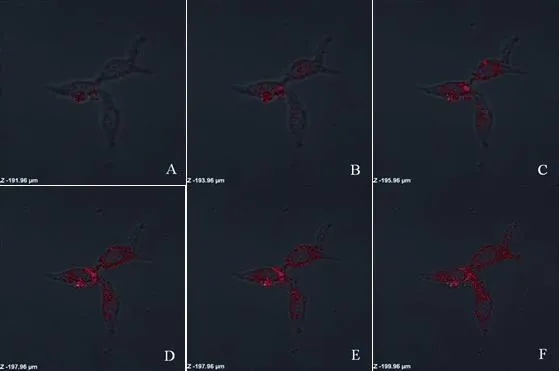上皮钙黏蛋白启动子-160 C/A位点单核苷酸多态性与鼻咽癌的相关性
2013-06-09金娜胡凯朱庆尧袁超王涛
金娜胡凯朱庆尧袁超王涛
1.华中科技大学同济医学院附属协和医院肿瘤中心,湖北 武汉430022;
2.广西医科大学第一附属医院肿瘤放疗中心,广西 南宁530007;
3.河南省人民医院肿瘤放射治疗科,河南 郑州 450000;
4.湖北省新华医院ICU,湖北 武汉 430015
上皮钙黏蛋白启动子-160 C/A位点单核苷酸多态性与鼻咽癌的相关性
金娜1胡凯2朱庆尧3袁超4王涛1
1.华中科技大学同济医学院附属协和医院肿瘤中心,湖北 武汉430022;
2.广西医科大学第一附属医院肿瘤放疗中心,广西 南宁530007;
3.河南省人民医院肿瘤放射治疗科,河南 郑州 450000;
4.湖北省新华医院ICU,湖北 武汉 430015
背景与目的:上皮钙黏蛋白(E-cadherin,E-cad)作为一种关键的结构蛋白对正常的细胞极性、上皮形态和细胞分化非常重要。最近有研究表明E-cad基因启动子区域-160 C/A基因多态性与鼻咽癌(nasopharyngeal carcinoma,NPC)的易感性有关。本研究旨在评价中国汉族人群中NPC危险性和E-cad基因启动子-160 C/A位点多态性的关系。方法:选取303例明确诊断为NPC的患者为实验组,同时选取318位健康志愿者为对照组。采用TaqMan探针技术检测启动子区域-160 C/A位点的单核苷酸多态性。结果:按性别和年龄调整后,实验组E-cad基因启动子-160 C/A位点A/A基因型危险性显著高于对照组(调整后OR=2.09,95%CI:1.03~4.22,P=0.04)。按性别分层后,女性NPC患者中A/A基因型危险性显著高于对照组(OR=7.57,95%CI:1.57~36.47,P=0.012)。此外,与NPC患者中男性A/A基因型比对,女性A/A基因型具有更高的患病风险(OR=2.66,95%CI:1.14~6.20,P=0.024)。结论:E-cad基因启动子-160 C/A位点的A/A基因型是中国汉族人群患NPC的危险因素之一,尤其对于女性患者尤为显著。
上皮钙黏蛋白;单核苷酸多态性;鼻咽癌
[Key words]E-cadherin; Single nucleotide polymorphism; Nasopharyngeal carcinoma
鼻咽癌(nasopharyngeal carcinoma,NPC)在我国是一种常见的恶性肿瘤,其发病具有明显的地域和家族倾向。NPC在我国广东、广西、湖南等地比较常见[1]。说明虽然Epstein-Barr病毒(EBV)感染、饮食、环境等因素与NPC有关,但遗传因素在NPC的发病中同样具有重要作用[2]。
上皮钙黏蛋白(E-cadherin,E-cad)是一种重要的钙依耐性上皮黏附蛋白,是维护上皮细胞组织形态、结构完整性和极性的重要分子[3]。E-cad也是重要的肿瘤转移抑制基因,其表达下降、丧失或分布异常是导致上皮细胞获得去分化和高侵袭性的重要环节[4]。无E-cad表达的细胞系表现出侵袭性生长的形式,而在DNA介导性转染E-cad后侵袭性有所下降[5]。E-cad在正常的上皮细胞和分化良好的癌细胞中表达,但是在分化差和未分化癌中表达显著下降[6]。许多人类肿瘤,如前列腺癌、结直肠癌和肾癌中E-cad表达下降或缺失。E-cad表达下降同样与人类头颈部肿瘤包括NPC的高肿瘤级别、侵袭性生长和淋巴结转移有关[7]。
E-cad基因定位于16号染色体q22.1,cDNA全长4.8 kb,人类E-cad基因组cDNA长达100 kb,含16个外显子[8]。目前有研究表明,E-cad基因启动子区域-160 C/A(rs16260)多态性对E-cad基因的转录调节有直接作用,与C等位基因相比,A等位基因会使E-cad启动子转录效率降低10%~68%[9]。E-cad基因-160 C/ A单核苷酸多态性和肿瘤易感性的关系已在许多肿瘤中被描述,如前列腺癌、胃癌、乳腺癌等[10]。本研究运用病例对照的方法,探讨E-cad基因启动子区域-160 C/A位点多态性与鼻咽癌危险性的关系。
1 资料和方法
1. 1 研究对象
研究分为两组,实验组(n=303)为华中科技大学同济医学院附属协和医院和同济医院2008年5月—2010年9月确诊的NPC患者。对照组(n=318)为华中科技大学同济医学院公共卫生学院收集的健康体检自愿者的血标本(排除有肿瘤病史,患有明确癌前病变,肿瘤家族史及其他严重疾病)。因NPC的发病率与性别、年龄相关,故在本研究前期将对照组与实验组按性别、年龄配比。
1.2 基因组DNA的提取
本研究统一使用含EDTA的试管收集两组患者的外周血标本,并按照DNA小提试剂盒(Axygen Biosciences, Union City,CA)说明进行规范操作,提取基因组DNA存放于-20 ℃的冰箱内。
1.3 标本DNA浓度的测定和稀释
采用NANODROP 1000分光光度仪检测所有标本DNA的浓度,然后用Buffer TE稀释,使所有标本的DNA浓度保持在5~10 ng/µL。
1.4 使用ABI 7900HT实时荧光定量PCR仪分型
1.4.1 PCR反应体系及反应条件
反应体系共5 µL,包括DNA 1 µL、TaqMan探针0.125 µL、TaqMan GT Master Mix 2.5 µL、去离子水1.375 µL。
PCR反应条件:①95℃加热10 min;②在92℃变性15 s;③在60℃退火60 s;④在60℃延伸60 s,并重复②至④步骤共40个循环。
1.4.2 使用SDS 2.3软件分析
PCR结束后,使用SDS2.3软件,在读取PCR结果时VIC荧光基团被设定为蓝色,FAM荧光基团被设定为红色,因此,包含A/A基因型的DNA模板在结果中显示为蓝色,包含C/C基因型的DNA模板显示为红色,而C/A基因型包含两种荧光基团显示为绿色(图1),不同基因型的扩增曲线(图2)。

图 1 等位基因的分型Fig. 1 Allelic discrimination

图 2 不同基因型的扩增曲线Fig. 2 Amplification plots of different genotypes
1.5 统计学处理
所有数据应用SPSS 17.0统计软件进行分析;采用t检验比较两组之间的年龄分布差异;采用四格表χ2检验和t检验比较两组之间性别分布差异以及验证基因型频率是否符合Hardy-Weinberg平衡定律;E-cad基因-160 C/A多态性与NPC易感性及侵袭性之间的相关性以比值比(odd ratio,OR)及其95%可信区间(confidence intervals,CI)表示;OR值及95%CI用以多元Logistic回归分析,并经校正年龄、性别等混杂因素所取得;P<0.05为差异有统计学意义。
2 结 果
2.1 临床资料比较与Hardy-Weinberg遗传平衡检验
实验组患者平均年龄为(47.14±11.188)岁,对照组为(46.58±6.796)岁(P=0.449)。经χ2检验得出实验组与对照组之间性别分布差异无统计学意义(P=0.734);经t检验得出两组之间的年龄分布差异无统计学意义(P=0.449);两组患者之间呈现良好的匹配性(表1);经χ2检验得出基因型频率分布符合Hardy-Weinberg遗传平衡定律(实验组P=0.054,对照组P=0.097)。
2.2 E-cad基因-160 C/A多态性与NPC易感性的关系
通过TaqMan探针检测,结果显示E-cad基因-160 C/A多态性在两组患者中均普遍存在。实验组A/A基因型频率显著高于对照组,经Logistic多因素回归分析,全部研究对象以有无NPC为因变量,性别、年龄、E-cad基因-160 C/A多态性为自变量,结果显示A/A基因型相对于C/C基因型是NPC易感发生的独立危险因素(P=0.040,OR=2.09,95%CI:1.03~4.22,表2)。
按照性别进行分层分析显示E-cad基因-160 C/A位点 A/A 基因型与女性患者易感性显著相关(P=0.012,OR=7.57,95%CI:1.57~36.47,表3)。

表 1 实验组和对照组的一般临床资料比较Tab. 1 General characteristics of cases and controls
2.3 E-cad基因-160 C/A多态性和NPC临床指标之间的关系
将NPC患者按恶性肿瘤的临床指标,包括性别、临床分期、TNM分期后再与E-cad基因-160 C/A多态性进行相关性分析时发现:与男性A/A基因型相比,女性A/A基因型患者患病风险显著增加(P=0.024,OR=2.66,95%CI: 1.14~6.20),而与肿瘤大小、淋巴结转移和远处转移无相关性(表4)。
3 讨 论
E-cad黏附功能的丧失是上皮细胞向更有侵袭性表型发展的关键步骤。E-cad的功能障碍与多种人类肿瘤包括头颈部肿瘤和NPC的高肿瘤级别、侵袭性生长和淋巴结转移有关[11]。同时,有研究表明NPC患者中E-cad下调是由于E-cad基因启动子区域的异常甲基化[12]。此外,E-cad水平与NPC的疾病发展是一致的:与原发肿瘤相比,转移性NPC肿瘤显示出更低的mRNA和蛋白质水平[13]。说明E-cad对NPC的发展具有重要意义。有报道表明人类肿瘤中存在E-cad的基因突变[14]。Perl等[15]的研究表明,E-cad基因涉及到一些组织类型的人类肿瘤的早期发展阶段,而且两个等位基因都失活。E-cad功能失活对癌症的发生很重要,这一点是明确的。有研究报道家族遗传性弥漫型胃癌存在E-cad种系突变[16-17]。调节区域染色质重组或DNA甲基化所致的E-cad启动子活性的下降会导致E-cad表达下调[18-19]。体内试验表明,E-cad启动子区域甲基化和肝癌细胞E-cad表达下降显著相关,并且甲基化在癌前病变中也经常被发现。

表 2 实验组和对照组E-cad基因-160 C/A多态性的表达频率Tab. 2 Distribution of E-cad-160C/A polymorphism frequencies in cases and controls

表 3 E-cad基因-160 C/A多态性与性别Tab. 3 Association between E-cad-160C/A polymorphism and gender

表 4 E-cad基因-160 C/A多态性与NPC临床指标的分析Tab. 4 Analyses of E-cad-160C/A polymorphism for clinic characteristics in NPC patients
此外,E-cad启动子区域的功能性基因多态性与几种肿瘤的易感性有关[20]。目前,-160 C/A单核苷酸多态性已经在E-cad基因启动子区域被确定[21]。研究表明A等位基因相对于野生型C等位基因,其转录效率降低了10%~68%[22-23]。并且C等位基因与A等位基因相比有更高的转录因子结合力,表明基因变异改变了E-cad基因的转录活性,并且与E-cad表达下降和上皮肿瘤易感性增加有关。-160 C/A等位基因变异频率在不同的地域和种族中有所不同。-160 A/A纯合子在中国人群中的频率为4.4%。最近在突尼斯人群中关于E-cad基因-160 C/A多态性与NPC的研究表明,A/A基因型具有更高的患NPC风险(OR=2.02,P=0.008),与NPC患者中C/C基因型相比,A/A和C/A基因型的风险分别高4.1倍和1.8倍,但是与NPC的转移和临床预后没有显著关系[7]。最近的流行病学研究表明,A/A基因型不增加前列腺癌的发病风险[24],而对胃癌来说具有保护作用[25],与乳腺癌和结直肠癌没有显著关系[26]。-160 C/A多态性与零散的弥漫性胃癌的易感性有关[27],但也有研究表明与胃癌的发病无关[28]。因此,E-cad基因-160 C/A多态性与肿瘤关系的研究仍有争议。
在本研究中发现E-cad基因-160 C/A多态性与NPC的发病显著相关,A/A基因型相对于C/C基因型具有更高的患病风险,尤其对于女性患者,但是与NPC的淋巴结转移及远处转移没有明显关系。综上所述,E-cad基因-160 C/A多态性作为NPC易感性的新发现,为该类肿瘤病因、诊治提供了更广阔的研究思路。继续深入明确E-cad启动子区域-160 C/A多态性中A/A基因型分子机制及其参与肿瘤细胞转移的过程,可为NCP的防治提供新策略。
[1] WEI W I, SHAM J S. Nasopharyngeal carcinoma [J]. Lancet, 2005, 365: 2041-2054.
[2] ZHENG Z, PAN J, CHU B, et al. Down regulation and abnormal expression of E-cadherin and beta-catenin in nasopharyngeal carcinoma: close association with advanced disease stage and lymph node metastasis [J]. Hum Pathol, 1999, 30: 458-466.
[3] GRUNWALD G B. The structural and functional analysis of cadherin calcium-dependent cell adhesion molecular [J]. Curr Opin Cell Biol, 1993, 5: 797-805.
[4] WANG G Y, LU C Q, ZHANG R M, et al. The E-cadherin gene polymorphism-160 C-A and cancer risk: A huge review and meta-analysis of case-control studies [J]. Am J Epidemiol, 2008, 167: 7-14.
[5] VLEMINCKX K, VAKAET L J R, MAREEL M, et al. Genetic manipulation of E-cadherin expression by epithelial tumor cells reveals an invasion suppressor role [J]. Cell, 1991, 66: 107-119.
[6] WANG G, HU X, LU C, et al. Promoter-hypermethylation associated defective expression of E-cadherin in primary nonsmall cell lung cancer [J]. Lung Cancer, 2008, 62: 162-172.
[7] BEN NASR H, HAMRITA B, BATBOUT M, et al. A single nucleotide polymorphism in the E-cadherin gene promoter -160 C/A is associated with risk of nasopharyngeal cancer[J]. Clin Chin Acta, 2010, 411: 1252-1257.
[8] BUSSEMAKERS M J, VAN BOKHOVEN A, MESS S G, et al. Molecular cloning and characterization of the human E-cadherin cDNA [J]. Mol Biol Rep, 1993, 17: 123-128.
[9] LI L C, CHUI R M, SASAKI M, et al. A single nucleotide polymorphismin the E-cadherin gene promoter alters transcriptional activities [J]. Cancer Res, 2000, 60: 873-876.
[10] VERHAGE B A, VAN HOUWELINGEN K, RUIJTER T E, et al. Single-nucleotide polymorphism in the E-cadherin gene promoter modifies the risk of prostate cancer [J]. Int J Cancer, 2002, 100(6): 683-685.
[11] ZHENG Z, PAN J, CHU B, et al. Downregulation and abnormal expression of E-cadherin and beta-catenin in nasopharyngeal carcinoma: close association with advanced disease stage and lymph node metastasis [J]. Hum Pathol, 1999, 30(4): 458-466.
[12] LI Z, REN Y, LIN S, et al. Association of E-cadherin and -catenin with metastasis in nasopharyngeal carcinoma [J]. Chin Med J (Engl), 2004, 117(8): 1232-1239.
[13] HUANG G W, MO W N, KUANG G Q, et al. Expression of p16, nm23-H1, E-cadherin, and CD44 gene products and their significance in nasopharyngeal carcinoma [J]. Laryngoscope, 2001, 111: 1465-1471.
[14] BERX G, BECKER K F, HOFLER H, et al. Mutation of the human E-cadherin (CDH1)gene [J]. Hum Mutat, 1998, 12: 226-237.
[15] PERL A K, WILGENBUS P, DAHL U, et al. Causal role for E-cadherin in the transition from adenoma to carcinoma [J]. Nature, 1998, 392: 190-193.
[16] HOPKINS J, GUILFORD P, HARRAWAY J, et al. E-cadherin germline mutations familial gastric cancer [J]. Nature, 1998, 392: 402-405.
[17] MCKEE S A, RICHARDS F M, RAJPAR M H, et al. Germline E-cadherin gene (CDH1) mutations predispose to gastric cancer and colorectal cancer [J].Hum Mol Genet, 1999, 8: 607-610.
[18] GRAFF J R, HERMAN J R, LAPIDUS R G, et al. E-cadherin expression is silenced by DNA hypermethylation in human breast and prostate carcinomas [J]. Cancer Res, 1995, 55: 5195-5199.
[19] HENNIG G, BEHRENS J, TRUSS M, et al. Progression of carcinoma cells is associated with alterations in chromatin structure and factor binding at the E-cadherin promoter in vivo [J]. Oncogene, 1995, 11: 475-484.
[20] VERHAGE B A, VAN HOUWELINGEN K, RUIJTER T E, et al. Single nucleotide polymorphism in the E-cadherin gene promoter modifies the risk of prostate cancer [J]. Int J Cancer, 2002, 100: 683-685.
[21] LI L C, CHUI R M, SASAKI M, et al. A single nucleotide polymorphism in the E-cadherin gene promoter alters transcriptional activities [J]. Cancer Res 2000, 60: 873-876.
[22] BERX G, CLETON-JANSEN A M, CORNELISSE C, et al. E-cadherin is a tumor invasion supressor gene mutated in human lobular breast cancer [J]. EMBO J, 1995, 14: 6107-6115.
[23] NAKAMURA A, SHIMAZAKI T, KANEKO K, et al. Characterization of DNA polymorphisms in the E-cadherin gene (CDH1) promoter region [J]. Mutat Res, 2002, 502:19-24.
[24] KURODA Y, TSUKINO H, IMAI H, et al. Lack of evidence for the associated of E-cadherin gene polymorphism with increased risk or progression of prostate cancer [J]. Urol Int, 2004, 74: 203-207.
[25] WU M S, HUANG S P, CHANG Y T, et al. Association of the -160C/A promoter polymorphism of E-cadherin gene with gastric carcinoma risk [J]. Cancer, 2002, 94: 1443-1448.
[26] GRUNHAGE F, JUNQCK M, LAMBERTI C, et al. Association of familial colorectal cancer with variants in the E-cadherin (CDH1) and cyclin D1 (CCND1) genes [J]. Int J Colorectal Dis, 2008, 23: 147-154.
[27] NASRI S, MORE H, GRAZIANO F, et al. A novel diffuse gastric cancer susceptibility variant in E-cadherin (CDH1) intron 2: a case control study in an Italian population [J]. BMC Cancer, 2008, 8: 138.
[28] PARK W S, CHO Y G, PARK Y J, et al. A single nucleotide polymorphisms in the E-cadherin gene promoter -160 is not associated with risk of Korean gastric cancer [J]. J Korean Med Sci, 2003, 18: 501-504.
The E-cadherin promoter -160 C/A polymorphism and nasopharyngeal carcinoma in a Chinese population
JIN Na1, HU Kai2, ZHU Qing-yao3, YUAN Chao4, WANG Tao1(1.Cancer Center, Union Hospital, Tongji Medical College, Huazhong University of Science and Technology, Wuhan Hubei 430022, China; 2.Radiotherapy Center of Oncology, the First Affiliated Hospital of Guangxi Medical University, Nanning Guangxi 530007, China; 3.Department of Radiation Oncology, Henan Provincial People’s Hospital, Zhengzhou Henan 450000, China; 4.Department of Intensive Care Unit, Hubei Xinhua Hospital, Wuhan Hubei 430015, China)
WANG Tao E-mail: hustwangtao@hotmail.com
Background and purpose: The E-cadherin as a pivotal structural protein is important for cellular polarity and maintainance of normal tissue morphology and cellular differentiation. Recently some study investigated the impact of the C/A genetic polymorphism at -160 from the site of the E-cadherin gene promoter on susceptibility in NPC. To evaluate the association of the E-cadherin gene promoter -160 C/A single nucleotide polymorphism (SNP) and nasopharyngeal carcinoma risk in a Chinese population, we designed a hospital-based case-control study. Methods: Subjects included in this study were 303 patients definitely diagnosed with NPC, and 318 matched healthy controls. We used TaqMan Probe method for analyzing polymorphism. Results: The A/A genotype was associated with increased risk of NPC after being adjusted for age and gender (adjusted OR=2.09, 95%CI: 1.03-4.22, P=0.04). When 2 gender groups were analysed respectively, female group with A/A genotypes showed a higher risk (OR=7.57, 95%CI: 1.57-36.47, P=0.012). Besides, among NPC patients compared with males A/A genotype, females with A/A genotype had a significant risk(OR=2.66, 95%CI: 1.14-6.20, P=0.024). Conclusion: The A/A genotype of E-cadherin promoter -160 C/ A might be genetic risk factor for NPC, especially female patients.
10.3969/j.issn.1007-3969.2013.07.006
R739.63
:A
:1007-3639(2013)07-0512-07
2012-12-07
2013-04-12)

王涛 E-mail:hustwangtao@hotmail.com
更正声明
<<中国癌症杂志>>2012年第22卷第4期刊登的文章“乳糖酸修饰mPEG-PLGA-PLL纳米粒靶向肝癌细胞Huh7的研究”,其中“图3 Huh7细胞体外摄取PEAL-GAL NPs的激光共聚焦断层扫描图片”,因作者原因误将对照组的结果当作实验组的结果使用,现对结果进行更正,正确的实验组结果如下图:
